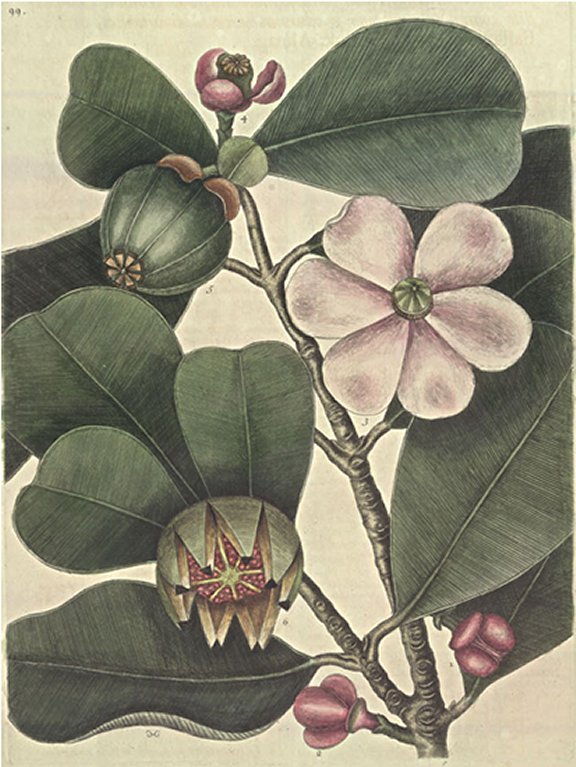Plate Number: II 99Cenchramidea Arbor Saxis adnescens, obrotundo pingui folio; fructu pomiformi, in plurimas capsulas granula ficulnea stilo columnari octogono praeduro adhaerenti continentes, diviso; Balsumum fundens: The Balsam-Tree These Trees usually grow about six Inches thick, and twenty Feet in Height, having a smooth light coloured Bark. The Leaves grow by Pairs, they are thick, and succulent, having a large Rib in the Middle, from which run transversely narrow streight Lines, parallel and close to one another: In June it produces ample fair Flowers, composed of six white Petals, stained with purple In the Middle of the Flower is formed the Rudiment of the Fruit, which is almost spherical, and increases to the Size of a midling Apple: From the Stalk to the Crown of the Fruit runs eight Lines like the Meridians on a Globe, from Pole to Pole. When the Fruit becomes ripe it opens at these Lines, and divides into eight Parts, disclosing many mucilaginous scarlet Seeds, resembling those of a Pomgranate, the Mucilage being washed off, the Seeds appear white, and hard, containing a Kernel. These Seeds are contained in the hollow Furrows of an Octogonal Core. The whole Plant is exceeding beautiful, and particularly the Structure of the Fruit in all it's Parts, is a most exquisite Piece of natural Mechanism. These Trees grow on Rocks, and frequently on the Limbs, and Trunks of Trees; occasioned by Birds scattering or voiding the Seeds which being glutinous like those of Misletto, take Root and grow. But finding not sufficient Nutriment to increase in Growth, the Roots spread on the Bark or Superficies of the Tree till they find a decayed Hole or other Lodgment wherein is some small Portion of Soil, into which they enter and become a Tree: But the Fertility of this Second Plantation being exhausted, one or more of the Roots are discharged out of the Hole, and fall directly to the Ground, tho' at forty Feet distance, here again they take Root, and become a much larger Tree than before: The Rosin of this Tree is used for the Cure of Sores in Horses, and also instead of Tallow for Boats and other Vessels. They grow on the Bahama Islands, and on many other Islands of America, between the Tropicks |